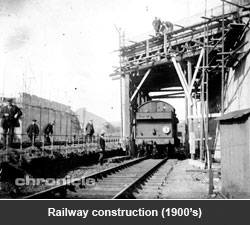
Railways
The first penetration by rail into the Caerphilly basin occurred in 1836 when the Rhymney Tramway was constructed. Later, this tramway became the Brecon and Merthyr railway, although the railway was some distance from the town of Caerphilly and did little to serve it.
The next railway link opened in 1858 and although much nearer to Caerphilly, it was still outside the town. This line left the Taff Vale railway at Walnut Tree Junction, Taffs Well and entered the Caerphilly basin through the Nantgarw gap. Passengers using the line had to alight at a small station behind the Station Inn in Nantgarw.
In 1868 a new railway station and a railway hotel were to be built near St. Martin's Church. This served as a more direct rail link to Cardiff via the Cefn Onn tunnel. The construction of this tunnel was a difficult undertaking with some loss of life during its construction. The first train to carry passengers ran through the tunnel on the 3rd December 1870.
In the days before privately owned cars, railways were the life-line to the outside world from Caerphilly. The station at Caerphilly with its four platforms was considered to be one of the busiest in South Wales. The railways were taken for granted. They spanned the valleys around Caerphilly on high viaducts and hauled the coal from local mines to Cardiff, the largest coal port in the world.
All early trains were pulled by steam locomotives and many engines were serviced at the Caerphilly Railway Works, the only main railway works in Wales. It was built for the Rhymney Railway in 1899 and taken over by the Great Western Railway at amalgamation in 1923.The works was enlarged with a new erecting shop in 1926. Some men considered themselves lucky to obtain work at 'the Sheds' as the alternative was work underground in the pits. Those who completed their apprenticeships could find work elsewhere, such as becoming Engineer Officers for the ships, which were then steam powered. With the withdrawal of steam on British Railways, the works closed in 1963 and the site converted into an industrial estate.
Working on the railways, like working in 'the Sheds', was a way of life. Son followed father into the job and each engine driver, who was the aristocrat of the job, saw to it that his locomotive was perfectly clean. Most drivers kept the same engine for many years.
Perhaps the most picturesque railway in South Wales was the old Brecon to Merthyr that ran across from Newport to Brecon and passed through the Caerphilly basin on the Monmouthshire side of the River Rhymney.
Image date: unknown
Location: unknown
Submitted by: unknown
Do you have any stories, images and interesting facts relating to this picture. Help Chronicle build a website of your Caerphilly County Borough memories. Email the webmaster telling us as much as you can about your pictures. Thank you
Description: